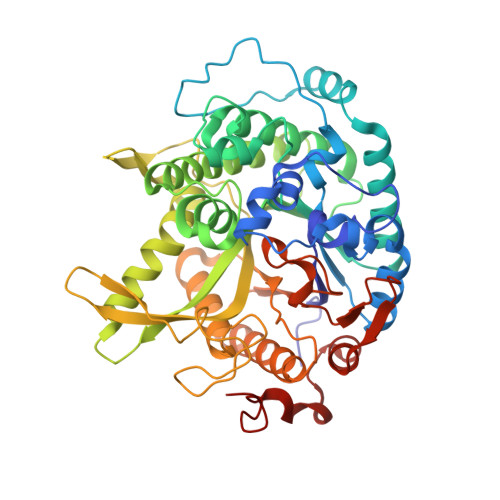A front-face 'SNi synthase' engineered from a retaining 'double-SN2' hydrolase.
Iglesias-Fernandez, J., Hancock, S.M., Lee, S.S., Khan, M., Kirkpatrick, J., Oldham, N.J., McAuley, K., Fordham-Skelton, A., Rovira, C., Davis, B.G.(2017) Nat Chem Biol 13: 874-881
- PubMed: 28604696
- DOI: https://doi.org/10.1038/nchembio.2394
- Primary Citation of Related Structures:
5I3D - PubMed Abstract:
S N i-like mechanisms, which involve front-face leaving group departure and nucleophile approach, have been observed experimentally and computationally in chemical and enzymatic substitution at α-glycosyl electrophiles. Since S N i-like, S N 1 and S N 2 substitution pathways can be energetically comparable, engineered switching could be feasible. Here, engineering of Sulfolobus solfataricus β-glycosidase, which originally catalyzed double S N 2 substitution, changed its mode to S N i-like. Destruction of the first S N 2 nucleophile through E387Y mutation created a β-stereoselective catalyst for glycoside synthesis from activated substrates, despite lacking a nucleophile. The pH profile, kinetic and mutational analyses, mechanism-based inactivators, X-ray structure and subsequent metadynamics simulations together suggest recruitment of substrates by π-sugar interaction and reveal a quantum mechanics-molecular mechanics (QM/MM) free-energy landscape for the substitution reaction that is similar to those of natural, S N i-like glycosyltransferases. This observation of a front-face mechanism in a β-glycosyltransfer enzyme highlights that S N i-like pathways may be engineered in catalysts with suitable environments and suggests that 'β-S N i' mechanisms may be feasible for natural glycosyltransfer enzymes.
Organizational Affiliation:
Departament de Química Inorgànica i Orgànica (Secció de Química Orgànica), Universitat de Barcelona, Barcelona, Spain.
















